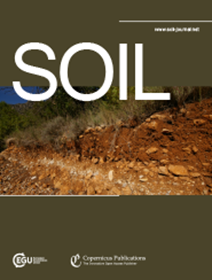Straw return with diverse nitrogen fertilizer application rates modulate ecosystem services and microbial traits in a meadow soil
IF 5.8
2区 农林科学
Q1 SOIL SCIENCE
引用次数: 0
Abstract
Abstract. Nitrogen (N) fertilization has received worldwide attention due to its benefits to soil fertility and productivity, but excess N application also causes an array of ecosystem dis-services, such as greenhouse gas emissions. Generally, soil microorganisms are considered to be involved in upholding a variety of ecosystem services and dis-services. However, the linkages between soil ecosystem services and microbial traits under different N fertilizer application rates remain uncertain. To address this, a 4-year in situ field experiment was conducted in a meadow soil on the Northeast China Plain after straw return with the following treatments combined with regular phosphorus (P) and potassium (K) fertilization: (i) regular N fertilizer (N+PK); (ii) 25 % N fertilizer reduction (0.75N+PK); (iii) 50 % N fertilizer reduction (0.5N+PK); and (IV) no N fertilizer (PK). Ecosystem services, dis-services and microbial traits responded distinctly to the different N fertilizer rates. Treatment 0.75N+PK had overall positive effects on soil fertility, productivity, straw decomposition, and microbial abundance and function and alleviated greenhouse effects due to N deficiency. Meanwhile, 0.75N+PK upregulated aboveground biomass and soil C:N and thus increased the abundance of genes encoding cellulose-degrading enzymes, which may imply the potential ability of C and N turnover. In addition, most observed changes in ecosystem services and dis-services were strongly associated with microbial modules and keystone taxa. Specifically, the Lasiosphaeriaceae-driven module 1 community promoted straw degradation and C and N release, while the Terrimonas-driven module 3 community contributed to production improvement, which was conducive to soil multifunctionality. Therefore, our results suggest that straw return with 25 % chemical N fertilizer reduction is optimal for achieving ecosystem services. This study highlights the importance of abiotic and biotic factors in soil health and supports green agricultural development by optimizing N fertilizer rates in meadow soil after straw return.不同氮肥施用量下秸秆还田对草甸土壤生态系统服务和微生物性状的影响
摘要。氮肥因其对土壤肥力和生产力的益处而受到全世界的关注,但过量施用氮肥也会导致一系列生态系统的不利服务,如温室气体排放。一般来说,土壤微生物被认为参与维持各种生态系统的服务和反服务。然而,不同施氮量下土壤生态系统服务功能与微生物性状之间的关系尚不明确。为了解决这一问题,在东北平原草甸土壤进行了秸秆还田后4年的原位田间试验,在常规磷钾施肥的基础上进行了以下处理:(1)常规氮肥(N+PK);(ii) 25%氮肥减量(0.75N+PK);(iii)氮肥减量50% (0.5N+PK);(四)不施氮肥(PK)。不同施氮量对生态系统服务、反服务和微生物性状有显著的响应。0.75N+PK处理对土壤肥力、生产力、秸秆分解、微生物丰度和功能均有总体正向影响,缓解了氮素缺乏造成的温室效应。同时,0.75N+PK上调了地上生物量和土壤C:N,从而增加了纤维素降解酶编码基因的丰度,这可能暗示了潜在的C和N转换能力。此外,大多数观测到的生态系统服务和反服务的变化与微生物模块和关键分类群密切相关。其中,lasiosphaeriaceae驱动的模块1群落促进了秸秆降解和碳氮释放,而terrimonas驱动的模块3群落促进了产量的提高,有利于土壤的多功能性。因此,我们的研究结果表明,秸秆还田减少25%的化学氮肥是实现生态系统服务的最佳选择。本研究通过优化秸秆还田后草甸土壤施氮量,突出非生物因子和生物因子对土壤健康的重要性,支持绿色农业发展。
本文章由计算机程序翻译,如有差异,请以英文原文为准。
求助全文
约1分钟内获得全文
求助全文
来源期刊

Soil
Agricultural and Biological Sciences-Soil Science
CiteScore
10.80
自引率
2.90%
发文量
44
审稿时长
30 weeks
期刊介绍:
SOIL is an international scientific journal dedicated to the publication and discussion of high-quality research in the field of soil system sciences.
SOIL is at the interface between the atmosphere, lithosphere, hydrosphere, and biosphere. SOIL publishes scientific research that contributes to understanding the soil system and its interaction with humans and the entire Earth system. The scope of the journal includes all topics that fall within the study of soil science as a discipline, with an emphasis on studies that integrate soil science with other sciences (hydrology, agronomy, socio-economics, health sciences, atmospheric sciences, etc.).
 求助内容:
求助内容: 应助结果提醒方式:
应助结果提醒方式:


